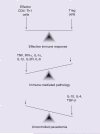Immunomodulation in Plasmodium falciparum malaria: experiments in nature and their conflicting implications for potential therapeutic agents
- PMID: 23241191
- PMCID: PMC3632711
- DOI: 10.1586/eri.12.118
Immunomodulation in Plasmodium falciparum malaria: experiments in nature and their conflicting implications for potential therapeutic agents
Abstract
Effective Plasmodium falciparum immunity requires a precisely timed and balanced response of inflammatory and anti-inflammatory immune regulators. These responses begin with innate immune effectors and are modulated over the course of an infection and between episodes to limit inflammation. To date, there are no effective immunomodulatory therapies for severe malaria. Some of the most potent immunomodulators are naturally occurring infections, including helminthic and chronic viral infections. This review examines malaria coinfection with these organisms, and their impact on malaria morbidity and immune responses. Overall, there is compelling evidence to suggest that chronic coinfections can modulate deleterious malaria-specific immune responses, suggesting that therapeutic agents may be effective if utilized early in infection. Examination of the mechanisms of these effects may serve as a platform to identify more targeted and effective malaria immunomodulatory therapeutics.
Figures

Similar articles
-
HIV Malaria Co-Infection Is Associated with Atypical Memory B Cell Expansion and a Reduced Antibody Response to a Broad Array of Plasmodium falciparum Antigens in Rwandan Adults.PLoS One. 2015 Apr 30;10(4):e0124412. doi: 10.1371/journal.pone.0124412. eCollection 2015. PLoS One. 2015. PMID: 25928218 Free PMC article.
-
Parasitic infections and immune function: effect of helminth infections in a malaria endemic area.Immunobiology. 2013 May;218(5):706-11. doi: 10.1016/j.imbio.2012.08.273. Epub 2012 Aug 20. Immunobiology. 2013. PMID: 22999162
-
Soluble markers of neutrophil, T-cell and monocyte activation are associated with disease severity and parasitemia in falciparum malaria.BMC Infect Dis. 2018 Dec 18;18(1):670. doi: 10.1186/s12879-018-3593-8. BMC Infect Dis. 2018. PMID: 30563486 Free PMC article.
-
Immunopathogenesis of falciparum malaria: implications for adjunctive therapy in the management of severe and cerebral malaria.Expert Rev Anti Infect Ther. 2011 Sep;9(9):803-19. doi: 10.1586/eri.11.96. Expert Rev Anti Infect Ther. 2011. PMID: 21905788 Review.
-
Effects of helminths and Mycobacterium tuberculosis infection on HIV-1: a cellular immunological perspective.Curr Opin HIV AIDS. 2012 May;7(3):260-7. doi: 10.1097/COH.0b013e3283521144. Curr Opin HIV AIDS. 2012. PMID: 22411452 Review.
Cited by
-
Association of Dengue Virus and Leptospira Co-Infections with Malaria Severity.Emerg Infect Dis. 2020 Aug;26(8):1645-1653. doi: 10.3201/eid2608.191214. Emerg Infect Dis. 2020. PMID: 32687019 Free PMC article.
-
A systematic review reveals that African children of 15-17 years demonstrate low hepatitis B vaccine seroprotection rates.Sci Rep. 2023 Dec 13;13(1):22182. doi: 10.1038/s41598-023-49674-1. Sci Rep. 2023. PMID: 38092870 Free PMC article.
-
The impact of COVID-19 pandemic on malaria elimination.Parasite Epidemiol Control. 2020 Nov;11:e00187. doi: 10.1016/j.parepi.2020.e00187. Epub 2020 Oct 20. Parasite Epidemiol Control. 2020. PMID: 33102823 Free PMC article. Review.
-
Endothelial-Leukocyte Interaction in Severe Malaria: Beyond the Brain.Mediators Inflamm. 2015;2015:168937. doi: 10.1155/2015/168937. Epub 2015 Sep 30. Mediators Inflamm. 2015. PMID: 26491221 Free PMC article. Review.
-
Expanding the antimalarial toolkit: Targeting host-parasite interactions.J Exp Med. 2016 Feb 8;213(2):143-53. doi: 10.1084/jem.20151677. Epub 2016 Feb 1. J Exp Med. 2016. PMID: 26834158 Free PMC article. Review.
References
-
- Riley EM, Wahl S, Perkins DJ, Schofield L. Regulating immunity to malaria. Parasite Immunol. 2006;28(1–2):35–49. - PubMed
-
- McCall MB, Sauerwein RW. Interferon-γ – central mediator of protective immune responses against the pre-erythrocytic and blood stage of malaria. J. Leukoc. Biol. 2010;88(6):1131–1143. - PubMed
Publication types
MeSH terms
Grants and funding
LinkOut - more resources
Full Text Sources
